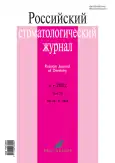Evaluation of the results of surgical treatment of adult patients with neoplasms of the parotid salivary glands
- Authors: Belchenko V.А.1, Chantyr I.V.1, Dorokhina N.I.2
-
Affiliations:
- Maxillofacial Hospital for War Veterans
- Pirogov Russian National Research Medical University
- Issue: Vol 26, No 3 (2022)
- Pages: 237-246
- Section: Organization of Healthcare Service
- Submitted: 16.05.2022
- Accepted: 06.07.2022
- Published: 28.09.2022
- URL: https://rjdentistry.com/1728-2802/article/view/107942
- DOI: https://doi.org/10.17816/1728-2802-2022-26-3-237-246
- ID: 107942
Cite item
Abstract
BACKGROUND: The issues of the early differential diagnosis of patients with neoplasms of the parotid salivary glands (PSG), choice of the correct tactics of surgical treatment, tumor recurrence, and postoperative complications have remained relevant for many years.
AIMS: To retrospectively analyze medical records of adult patients with neoplasms of the PSGs.
MATERIALS AND METHODS: We analyzed a sample of patients who were hospitalized at the Maxillofacial Hospital for War Veterans of the Department of Health of the City of Moscow for the period from January 2017 to April 2022.
RESULTS: The study included 302 patients (men, 38.41%; n=116; women, 61.59%; n=186). The mean age of the patients was 52.27±0.23 years. The study group was divided into three subgroups: the first group had benign neoplasms (n=258), the second group had malignancies (n=24), and the third group had tumor-like lesions (n=20). The article presents the main characteristics of these patients. Some features of diagnostics and planning were revealed. The authors discuss the choice of tactics of surgical techniques.
CONCLUSIONS: Despite the significant development in diagnostic and surgical techniques, discrepancies between clinical and pathohistological diagnoses (28.15%) and unwanted postoperative complications remain relatively high.
Full Text
About the authors
Victor А. Belchenko
Maxillofacial Hospital for War Veterans
Email: khmaro.neonila@mail.ru
ORCID iD: 0000-0002-6459-1909
SPIN-code: 2029-0401
MD, Dr. Sci. (Med.), Professor
Russian Federation, MoscowIvan V. Chantyr
Maxillofacial Hospital for War Veterans
Email: khmaro.neonila@mail.ru
ORCID iD: 0000-0002-9337-855X
SPIN-code: 4421-1932
Russian Federation, Moscow
Neonila I. Dorokhina
Pirogov Russian National Research Medical University
Author for correspondence.
Email: khmaro.neonila@gmail.com
ORCID iD: 0000-0002-5737-1801
SPIN-code: 3422-5710
Russian Federation, Moscow
References
- Lubin D, Song S, Baloch Z, et al. Pathology of Benign and Malignant Neoplasms of Salivary Glands. Oper Tech Otolayngol Head Neck Surg. 2018;29(3):101–115. doi: 10.1016/j.otot.2018.06.001
- Chernyavskii VI, Truten VP, Abduvosidov KA, Tolstykh MP. A Contemporary View on the Anatomy of Parotid Gland. Journal of Anatomy and Histopathology. 2021;10(4):76–84. (In Russ.). doi: 10.18499/2225-7357-2021-10-4-76-84
- Murashko RA, Alekseenko SN, Koshkarov AA, et al. Patient routing and process approach implementation for regional oncology service. Kuban Scientific Medical Bulletin. 2021;28(1):84–102. (In Russ.). doi: 10.25207/1608-6228-2021-28-1-84-102
- Drobyshev AYu, Shipkova ТP, Bykova АА, Kosminskaya AR. Improvement of diagnostic and treatment efficiency of patients with neoplasms of salivary glands using magnetic resonant tomography with contrast amplification. Vestnik of KSMA named after I.K. Akhunbaev. 2020;3(3):63–74. Available from: https://vestnik.kgma.kg/index.php/vestnik/article/view/42. (In Russ).
- Pakhomova NV, Kalakutskiy NV, Petropavlovskaya OYu, Grachev DI. An integrated approach to the diagnosis and surgical treatment of patients with neoplasms of the parotid salivary glands and paralysis of mimic muscles. International Journal of Applied and Fundamental Research. 2018;(1):84–88. (In Russ). doi: 10.17513/mjpfi.12070
- Levenets AA. Methodical approaches to the technology for parotid salivary gland removal with preparation of facial nerve branches. Siberian Medical Review. 2019;(5):97–103. (In Russ). doi: 10.20333/2500136-2019-5-97-103
- Martin H, Jayasinghe J, Lowe T. Superficial parotidectomy versus extracapsular dissection: literature review and search for a gold standard technique. Int J Oral Maxillofac Surg. 2020;49(2):192–199. doi: 10.1016/j.ijom.2019.06.006
- Yaremenko AI, Rybakova MG, Harutyunyan GG, et al. Clinical and morphological parallels in the surgical treatment of patients with pleomorphic parotid gland adenoma. Head and Neck Journal. 2021;9(4):51–58. (In Russ).
- Psychogios G, Bohr C, Constantinidis J, et al. Review of surgical techniques and guide for decision making in the treatment of benign parotid tumors. Eur Arch Otorhinolaryngol. 2021;278(7):15–29. doi: 10.1007/s00405-020-06250-x
- Kovalevskiy AM, Bocharnikov AA. Benign neoplasms of the salivary glands: treatment, postoperative complications and their control (literature review). Institute of Dentistry. 2017;(2):50–52. Available from: https://instom.spb.ru/catalog/article/10648/. (In Russ).
- Bonavolontà P, Dell’Aversana Orabona G, Maglitto F, et al. Postoperative complications after removal of pleomorphic adenoma from the parotid gland: A long-term follow up of 297 patients from 2002 to 2016 and a review of publications. Br J Oral Maxillofac Surg. 2019;57(10):998–1002. doi: 10.1016/j.bjoms.2019.08.008
- Carlson ER, McCoy GM. Margins for Benign Salivary Gland Neoplasms of the Head and Neck. Oral Maxillofacial Surg. 2017;29(3):325–340. doi: 10.1016/j.coms.2017.03.009
- Luijmes RE, Pouwels S, Beurskens C, et al. Quality of Life Before and After Different Treatment Modalities in Peripheral Facial Palsy: A Systematic Review. Laryngoscope. 2017;127(5):1044–1051. doi: 10.1002/lary.26356
- Carlson ER, Schlieve T. Salivary Gland Malignancies. Oral Maxillofacial Surg. 2019;31(1):125–144. doi: 10.1016/j.coms.2018.08.007
- Verbo EV, Kraytor AS. Clinical guidelines for benign tumors and tumor-like lesions of the parotid salivary glands. Moscow; 2017. 22 p. Available from: http://mfsrus.ru/documents/clinical-guidelines.php. (In Russ).
Supplementary files











